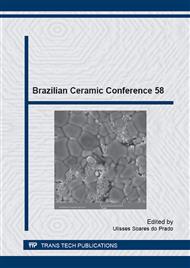p.239
p.244
p.250
p.256
p.262
p.268
p.274
p.280
p.287
Hot Pressing Sintering of ZrB2 with β-SiC Addition
Abstract:
Zirconium diboride (ZrB2) is a material of particular interest because of the excellent and unique property combination of high melting point, high electrical and thermal conductivity. In this work, the effect of addition of beta-silicon carbide (β-SiC) on hot pressing sintering of ZrB2 was investigated. Four compositions were studied with 0, 10, 20 e 30 vol% of SiC. ZrB2 powder and mixtures were prepared by planetary milling with SiC spheres during 4 h. Samples were sintered at 1850 °C/1h with a pressure of 20 MPa in argon atmosphere. β-SiC has undergone phase transformation to α-SiC during sintering. The addition of SiC increased densification with increasing of SiC content. The total densification of sample was 96.8 % of theoretical density for sample with 30 vol% of SiC and Vickers hardness was 19.9 ± 0.3 GPa.
Info:
Periodical:
Pages:
262-267
Citation:
Online since:
June 2015
Authors:
Keywords:
Price:
Сopyright:
© 2015 Trans Tech Publications Ltd. All Rights Reserved
Share:
Citation:


